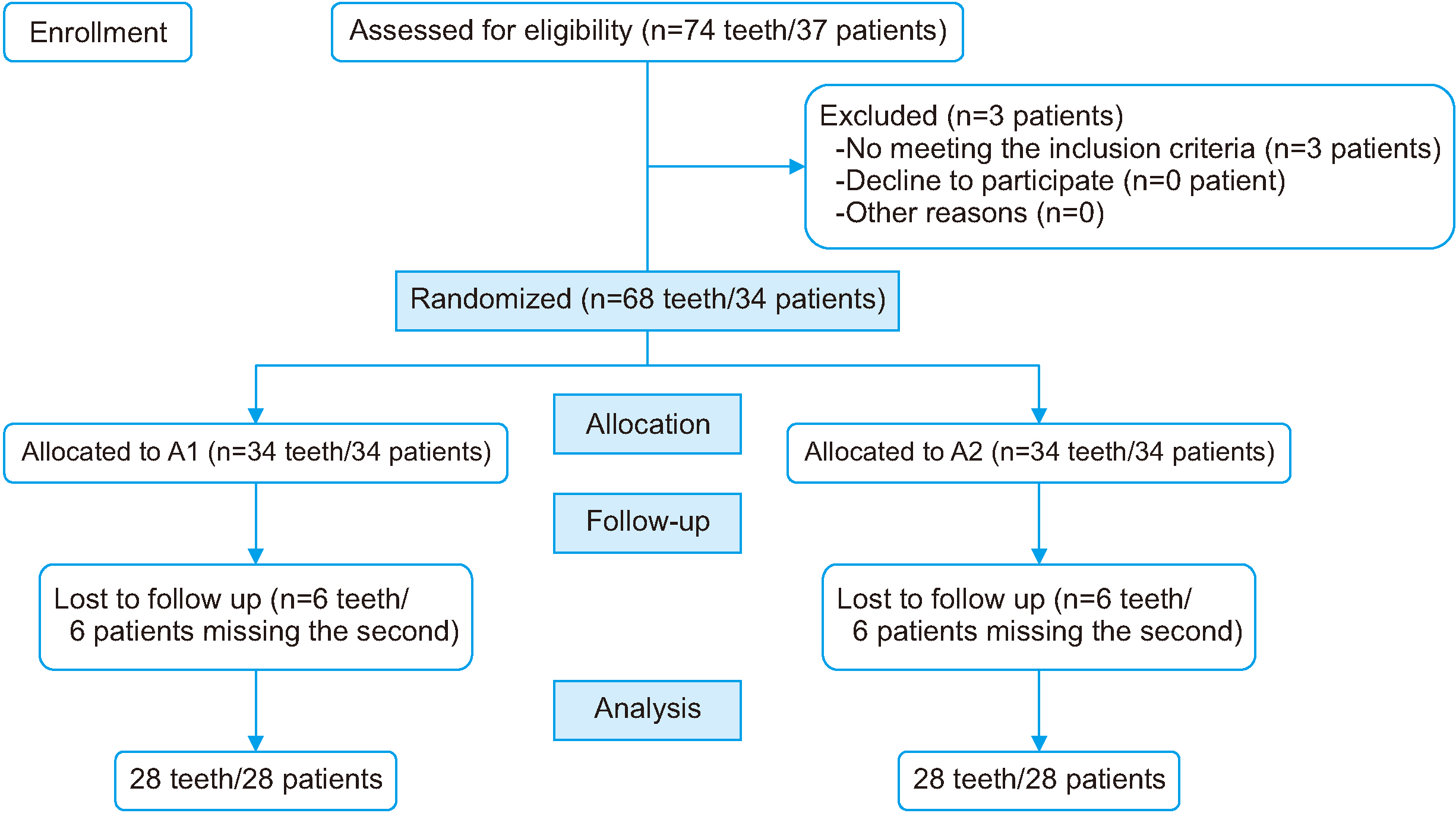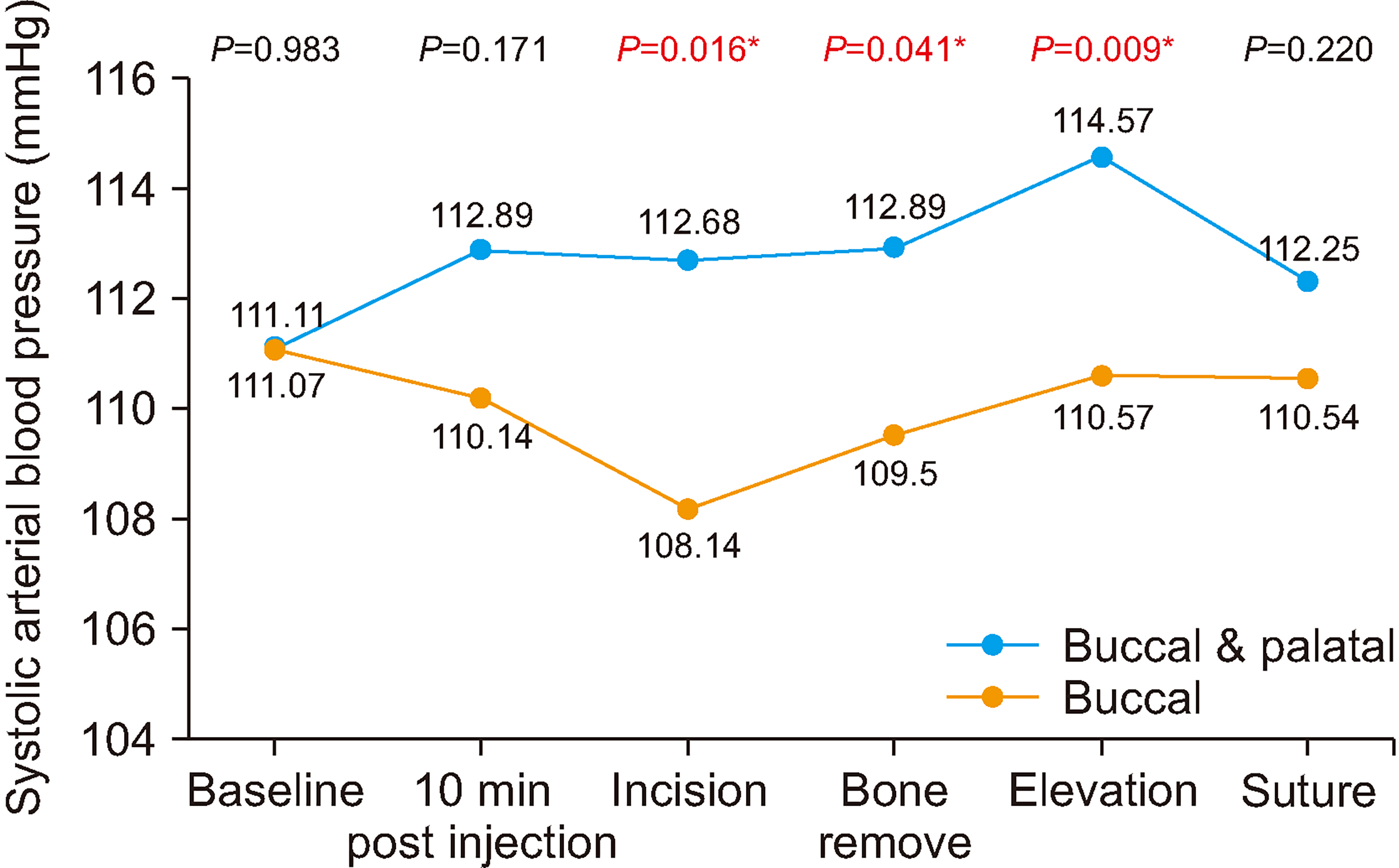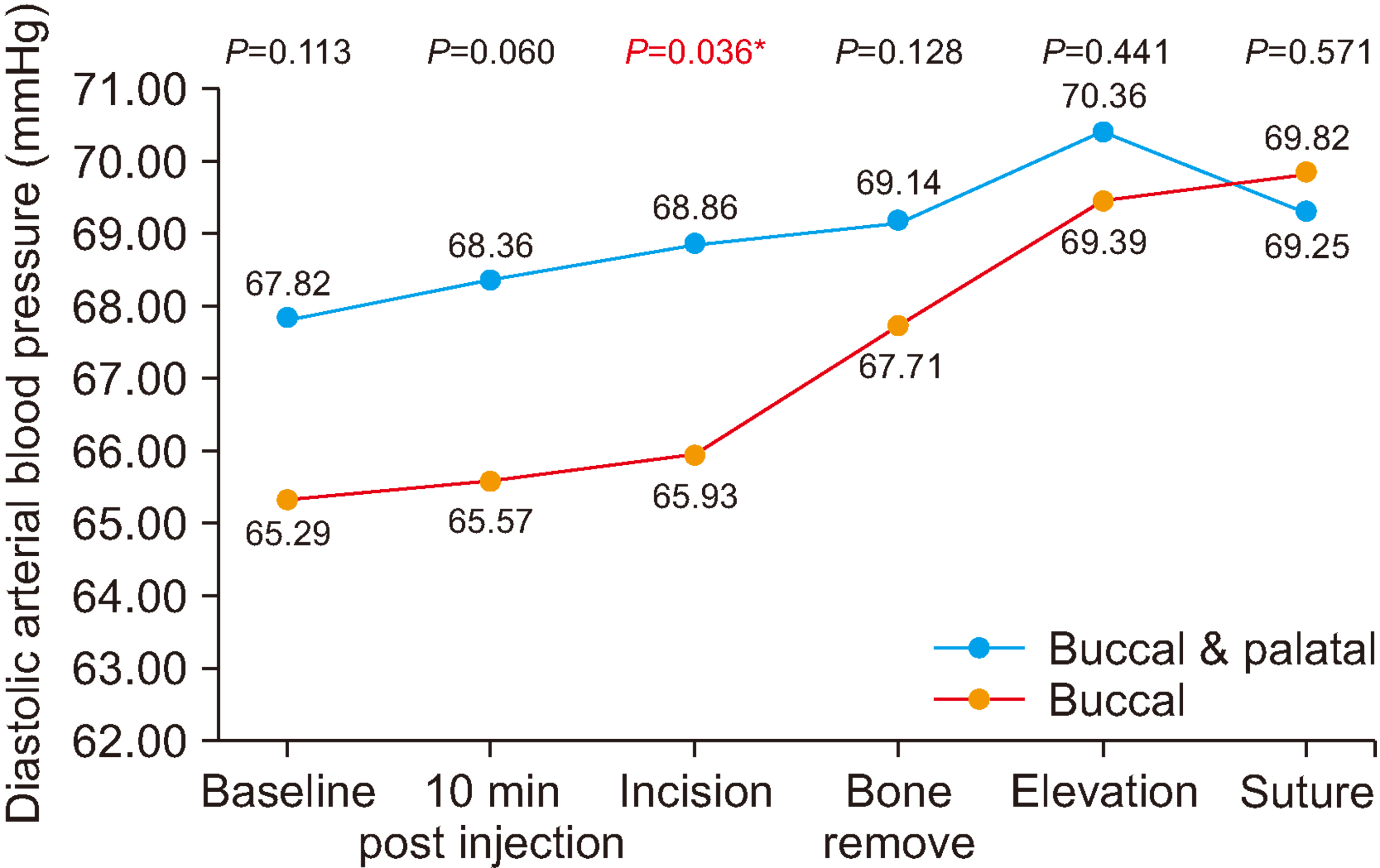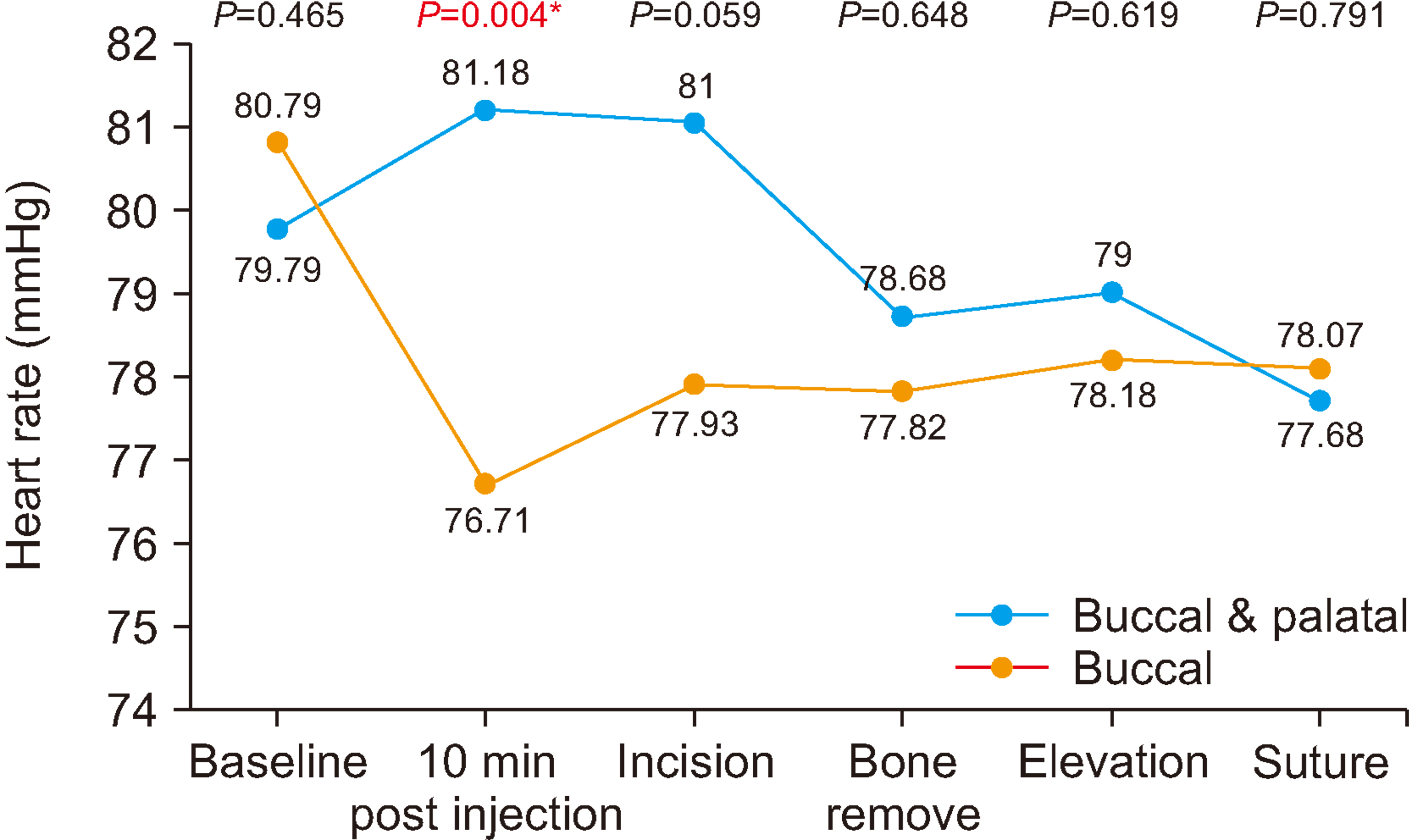J Korean Assoc Oral Maxillofac Surg.
2020 Aug;46(4):250-257. 10.5125/jkaoms.2020.46.4.250.
Buccal infiltration injection without a 4% articaine palatal injection for maxillary impacted third molar surgery
- Affiliations
-
- 1Department of Oral & Maxillofacial Surgery, Faculty of Dentistry, Mahidol University, Bangkok, Thailand
- 2Consultant of International College of Dentistry Committee, Walailuk University International College of Dentistry, Bangkok, Thailand
- KMID: 2505443
- DOI: http://doi.org/10.5125/jkaoms.2020.46.4.250
Abstract
Objectives
Palatal infiltration is the most painful and uncomfortable anesthesia technique for maxillary impacted third molar surgery (MITMS). This approach could cause patients distress and aversion to dental treatment. The aim of this study was to evaluate the anesthetic efficacy of a buccal infiltration injection without a palatal injection in MITMS.
Materials and Methods
This prospective research study was a crossover split mouth-randomized controlled trial. Twenty-eight healthy symmetrical bilateral MITMS patients (mean age, 23 years) were randomly assigned to two groups. Buccal infiltration injections without palatal injections were designated as the study group and the buccal with palatal infiltration cases were the control group, using 4% articaine and 1:100,000 epinephrine. The operation started after 10 minutes of infiltration. Pain assessment was done using a visual analogue scale and a numeric rating scale after each injection and extraction procedure. Similarly, the success rate, hemodynamic parameters, and additional requested local anesthetic were assessed.
Results
The results showed that the pain associated with local anesthetic injections between both groups were significantly different. However, the success rates between the groups were not significantly different. Postoperative pain was not significant between both groups and a few patients requested an additional local anesthetic, but the results were not statistically significant. For hemodynamic parameters, there was a significant difference in systolic pressure during incision, bone removal, and tooth elevation. In comparison, during the incision stage there was a significant difference in diastolic pressure; however, other steps in the intervention were not significantly different between groups.
Conclusion
We concluded that buccal infiltration injection without palatal injection can be an alternative technique instead of the conventional injection for MITMS.
Keyword
Figure
Reference
-
References
1. McCoy JM. 2012; Complications of retention: pathology associated with retained third molars. Atlas Oral Maxillofac Surg Clin North Am. 20:177–95. https://doi.org/10.1016/j.cxom.2012.06.002. DOI: 10.1016/j.cxom.2012.06.002. PMID: 23021395.
Article2. Rakprasitkul S. 2001; Pathologic changes in the pericoronal tissues of unerupted third molars. Quintessence Int. 32:633–8.3. Colombini BL, Modena KC, Calvo AM, Sakai VT, Giglio FP, Dionísio TJ, et al. 2006; Articaine and mepivacaine efficacy in postoperative analgesia for lower third molar removal: a double-blind, randomized, crossover study. Oral Surg Oral Med Oral Pathol Oral Radiol Endod. 102:169–74. https://doi.org/10.1016/j.tripleo.2005.09.003. DOI: 10.1016/j.tripleo.2005.09.003. PMID: 16876058.
Article4. McArdle BF. 1997; Painless palatal anesthesia. J Am Dent Assoc. 128:647. https://doi.org/10.14219/jada.archive.1997.0265. DOI: 10.14219/jada.archive.1997.0265. PMID: 9150649.
Article5. Gregorio LV, Giglio FP, Sakai VT, Modena KC, Colombini BL, Calvo AM, et al. 2008; A comparison of the clinical anesthetic efficacy of 4% articaine and 0.5% bupivacaine (both with 1:200,000 epinephrine) for lower third molar removal. Oral Surg Oral Med Oral Pathol Oral Radiol Endod. 106:19–28. https://doi.org/10.1016/j.tripleo.2007.11.024. DOI: 10.1016/j.tripleo.2007.11.024. PMID: 18420431.
Article6. Malamed SF. 2012. Handbook of local anesthesia. 6th ed. Mosby;St. Louis: p. 79.7. Isik K, Kalayci A, Durmus E. 2011; Comparison of depth of anesthesia in different parts of maxilla when only buccal anesthesia was done for maxillary teeth extraction. Int J Dent. 2011:575874. https://doi.org/10.1155/2011/575874. DOI: 10.1155/2011/575874. PMID: 21961002. PMCID: PMC3179870.
Article8. Lima-Júnior JL, Dias-Ribeiro E, de Araújo TN, Ferreira-Rocha J, Honfi-Júnior ES, Sarmento CF, et al. 2009; Evaluation of the buccal vestibule-palatal diffusion of 4% articaine hydrochloride in impacted maxillary third molar extractions. Med Oral Patol Oral Cir Bucal. 14:E129–32.9. Bataineh AB, Al-Sabri GA. 2017; Extraction of maxillary teeth using articaine without a palatal injection: a comparison between the anterior and posterior regions of the maxilla. J Oral Maxillofac Surg. 75:87–91. https://doi.org/10.1016/j.joms.2016.06.192. DOI: 10.1016/j.joms.2016.06.192. PMID: 27528103.
Article10. Uckan S, Dayangac E, Araz K. 2006; Is permanent maxillary tooth removal without palatal injection possible? Oral Surg Oral Med Oral Pathol Oral Radiol Endod. 102:733–5. https://doi.org/10.1016/j.tripleo.2005.12.005. DOI: 10.1016/j.tripleo.2005.12.005. PMID: 17138173.
Article11. Badcock ME, Gordon I, McCullough MJ. 2007; A blinded randomized controlled trial comparing lignocaine and placebo administration to the palate for removal of maxillary third molars. Int J Oral Maxillofac Surg. 36:1177–82. https://doi.org/10.1016/j.ijom.2007.06.001. DOI: 10.1016/j.ijom.2007.06.001. PMID: 18022350.
Article12. Fan S, Chen WL, Yang ZH, Huang ZQ. 2009; Comparison of the efficiencies of permanent maxillary tooth removal performed with single buccal infiltration versus routine buccal and palatal injection. Oral Surg Oral Med Oral Pathol Oral Radiol Endod. 107:359–63. https://doi.org/10.1016/j.tripleo.2008.08.025. DOI: 10.1016/j.tripleo.2008.08.025. PMID: 18996033.
Article13. Lima JL Jr Jr, Dias-Ribeiro E, Ferreira-Rocha J, Soares R, Costa FW, Fan S, et al. 2013; Comparison of buccal infiltration of 4% articaine with 1 : 100,000 and 1 : 200,000 epinephrine for extraction of maxillary third molars with pericoronitis: a pilot study. Anesth Prog. 60:42–5. https://doi.org/10.2344/0003-3006-60.2.42. DOI: 10.2344/0003-3006-60.2.42. PMID: 23763558. PMCID: PMC3683879.
Article14. Park WH, Choi SY, Kim CS. 2012; Study on the position of the posterior superior alveolar artery in relation to the performance of the maxillary sinus bone graft procedure in a Korean population. J Korean Assoc Oral Maxillofac Surg. 38:71–7. https://doi.org/10.5125/jkaoms.2012.38.2.71. DOI: 10.5125/jkaoms.2012.38.2.71.
Article15. Lima TC, Bagordakis E, Falci SGM, Dos Santos CRR, Pinheiro MLP. 2018; Pre-emptive effect of dexamethasone and diclofenac sodium associated with codeine on pain, swelling, and trismus after third molar surgery: a split-mouth, randomized, triple-blind, controlled clinical trial. J Oral Maxillofac Surg. 76:60–6. https://doi.org/10.1016/j.joms.2017.06.012. DOI: 10.1016/j.joms.2017.06.012. PMID: 28675812.
Article16. Sharma K, Sharma A, Aseri M, Batta A, Singh V, Pilania D, et al. 2014; Maxillary posterior teeth removal without palatal injection -truth or myth: a dilemma for oral surgeons. J Clin Diagn Res. 8:ZC01–4. https://doi.org/10.7860/JCDR/2014/10378.5092. DOI: 10.7860/JCDR/2014/10378.5092. PMID: 25584295. PMCID: PMC4290274.
Article17. Somuri AV, Rai AB, Pillai M. 2013; Extraction of permanent maxillary teeth by only buccal infiltration of articaine. J Maxillofac Oral Surg. 12:130–2. https://doi.org/10.1007/s12663-012-0396-0. DOI: 10.1007/s12663-012-0396-0. PMID: 24431829. PMCID: PMC3682005.
Article18. Martin M, Nusstein J, Drum M, Reader A, Beck M. 2011; Anesthetic efficacy of 1.8 mL versus 3.6 mL of 4% articaine with 1:100,000 epinephrine as a primary buccal infiltration of the mandibular first molar. J Endod. 37:588–92. https://doi.org/10.1016/j.joen.2011.01.001. DOI: 10.1016/j.joen.2011.01.001. PMID: 21496653.
Article19. Brand HS, Abraham-Inpijn L. 1996; Cardiovascular responses induced by dental treatment. Eur J Oral Sci. 104:245–52. https://doi.org/10.1111/j.1600-0722.1996.tb00074.x. DOI: 10.1111/j.1600-0722.1996.tb00074.x. PMID: 8831058.
Article20. Sapira JD, Bron K. 1971; Human epinephrine secretion. Direct measurement of the secretion of epinephrine from the human adrenal medulla. J Clin Endocrinol Metab. 33:436–47. https://doi.org/10.1210/jcem-33-3-436. DOI: 10.1210/jcem-33-3-436. PMID: 5571095.
Article21. Lipp M, Dick W, Daubländer M, Fuder H, Stanton-Hicks M. 1993; Exogenous and endogenous plasma levels of epinephrine during dental treatment under local anesthesia. Reg Anesth. 18:6–12. PMID: 8448101.22. Troullos ES, Goldstein DS, Hargreaves KM, Dionne RA. 1987; Plasma epinephrine levels and cardiovascular response to high administered doses of epinephrine contained in local anesthesia. Anesth Prog. 34:10–3. PMID: 3472472. PMCID: PMC2186227.23. de Morais HH, de Santana Santos T, Araújo FA, Vajgel A, de Holanda Vasconcellos RJ. 2012; Hemodynamic changes comparing lidocaine HCl with epinephrine and articaine HCl with epinephrine. J Craniofac Surg. 23:1703–8. https://doi.org/10.1097/SCS.0b013e31826bec3b. DOI: 10.1097/SCS.0b013e31826bec3b. PMID: 23147329.
Article
- Full Text Links
- Actions
-
Cited
- CITED
-
- Close
- Share
- Similar articles
-
- Single buccal infiltration of high concentration lignocaine versus articaine in maxillary third molar surgery
- Buffered articaine infiltration for primary maxillary molar extractions: a randomized controlled study
- Can single buccal infiltration with 4% articaine induce sufficient analgesia for the extraction of primary molars in children: a systematic literature review
- Anesthetic efficacy of buffered 4% articaine for mandibular first molar infiltration: a crossover clinical trial
- Anesthetic efficacy and safety of 2% lidocaine hydrochloride with 1:100,000 adrenaline and 4% articaine hydrochloride with 1:100,000 adrenaline as a single buccal injection in the extraction of maxillary premolars for orthodontic purposes







